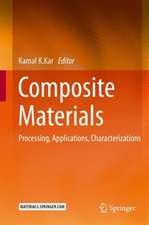Polymer Rheology: Theory and Practice
Autor Y.G. Yanovskyen Limba Engleză Hardback – 30 sep 1993
| Toate formatele și edițiile | Preț | Express |
|---|---|---|
| Paperback (1) | 1216.95 lei 6-8 săpt. | |
| SPRINGER NETHERLANDS – 17 sep 2012 | 1216.95 lei 6-8 săpt. | |
| Hardback (1) | 1224.36 lei 6-8 săpt. | |
| SPRINGER NETHERLANDS – 30 sep 1993 | 1224.36 lei 6-8 săpt. |
Preț: 1224.36 lei
Preț vechi: 1493.13 lei
-18% Nou
Puncte Express: 1837
Preț estimativ în valută:
234.28€ • 244.61$ • 193.90£
234.28€ • 244.61$ • 193.90£
Carte tipărită la comandă
Livrare economică 05-19 aprilie
Preluare comenzi: 021 569.72.76
Specificații
ISBN-13: 9780412534607
ISBN-10: 0412534606
Pagini: 298
Ilustrații: XI, 298 p. 7 illus.
Dimensiuni: 152 x 229 x 22 mm
Greutate: 0.64 kg
Ediția:1993
Editura: SPRINGER NETHERLANDS
Colecția Springer
Locul publicării:Dordrecht, Netherlands
ISBN-10: 0412534606
Pagini: 298
Ilustrații: XI, 298 p. 7 illus.
Dimensiuni: 152 x 229 x 22 mm
Greutate: 0.64 kg
Ediția:1993
Editura: SPRINGER NETHERLANDS
Colecția Springer
Locul publicării:Dordrecht, Netherlands
Public țintă
ResearchCuprins
1 Some Theoretical and Numerical Approaches to Describing the Viscoelastic Properties of Polymer Systems.- 1.1 Introduction.- 1.2 Single Molecule Approach in the Theory of Viscoelasticity of Polymer Concentrated Solutions and Melts.- 1.3 Imitation Modeling by the Method of Brownian Dynamics of the Viscoelastic Behavior of Polymers.- 1.4 Structural Approach to Modeling the Behavior of Filled Polymers.- 1.5 A Geometric Approach to Modeling the Behavior of Filled Polymers.- 1.6 Conclusion.- References.- 2 Rheological Properties, Relaxation Behavior, and Rupture of Polymers at Temperatures above their Glass Transition Temperature.- 2.1 Introduction.- 2.2 Viscoelastic Behavior in Low-Amplitude Shear.- 2.3 Viscoelastic Behavior in Continuous Shear Deformation.- 2.4 Viscoelastic Behavior in Uniaxial Extension.- 2.5 Relaxation Transition of Polymers in the Triaxial Stressed State.- 2.6 Relation between Relaxation Properties and Laws of Polymer Fracture.- References.- 3 Rheological Relaxation Properties of Polymer Blends.- 3.1 Introduction.- 3.2 General Problems of Description of Polymer Blends Properties.- 3.3 Qualitative Appraisals of Structural-Morphological Properties of Blends: Classification.- 3.4 Rheological Properties of Limitedly Compatible Blends.- 3.5 Rheological Properties of Incompatible Blends.- 3.6 Model Approaches.- 3.7 Conclusion.- References.- 4 Rheological and Relaxation Properties of Copolymers.- 4.1 Introduction.- 4.2 General and Specific Features.- 4.3 Two-Block Copolymers.- 4.4 Three-Block Copolymers.- 4.5 Features of the Rheological and Relaxation Behavior of Compositions Including Copolymers.- References.- 5 Rheological and Relaxation Properties of Filled Polymers.- 5.1 Introduction.- 5.2 Properties of a Polymer in a Filled System.- 5.3 Properties of a Filler in a Filled System.- 5.4 Physicochemical Aspects of Reinforcement.- 5.5 Some Aspects of the Rheological Appraisal of Mixing Quality.- 5.6 Model Behavior of Viscoelastic Properties of Filled Polymers.- 5.7 Influence of Filler ‘Activity’.- 5.8 Dynamic Rheological Characterization.- 5.9 Relation between Rheological and Strength Characteristics.- 5.10 Relaxation Behavior.- 5.11 Conclusion.- References.- Appendix 1. The Prototype Program of the Brownian Dynamic Method.- Appendix 2. The Prototype Program of the Finite Element Method.
Recenzii
...of interest to the specialist - Trends in Polymer Science; The book can certainly be recommended - eactive Polymers; The book contains many valuable references to the viscoelastic behaviour of polymers that are published in the original literature - Chemistry & Industry; Polymer reactor engineering is a well-structured account of its topic and I would strongly recommend it to those working with, or considering the use of, polymers reactor systems - Chemistry & Industry; ucontains a stimulating, if occasionally provocative, compliation of intellectual endeavour and experimental results - Composites Manufacturing










